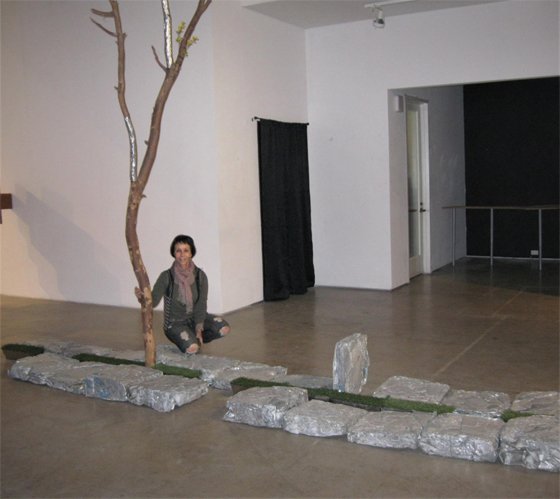
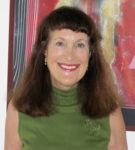
SAN DIEGO — There is a new exhibit at the San Diego Art Institute (SDAI) that should appeal to many tastes as it is an innovative show that pairs artists and scientists together. What a brilliant idea to combine art and science together! The new installation, “Illumination,” paired 16 artists with seven scientific institutions, along with ten artists doing their own interpretation of science, nature, and technology. The curator of this show, Chi Essary, did a wonderful job pairing the artists with their scientific counterparts.
I also like the fact that it is a multinational, multicultural affair as some of the artists participating are American, Mexican, Indian, Turkish, Chinese, Korean, and Egyptian.
Artist Becky Guttin was paired with a Chinese scientist studying Alzheimer’s disease: Dr. LuLin Jiang, who does her research at Sanford Burnham Prebys Medical Discovery Institute. In working and speaking with the doctor, three words stood out to Guttin which were “clean,” “dirt,” and “dust.”
As Guttin herself puts it, “Visiting my new friend, scientist LuLin, in her laboratory was extremely interesting and special. She talked about Alzheimer’s disease from the scientific point of view. Her knowledge helped me understand better what causes it and how difficult it has been to find a cure or to slow down its progression. She explained that when a person is suffering from Alzheimer’s, the “bad protein” called Beta Amyloidal, accumulates in the brain, adding “dust” to the brain cells.
“While listening to LuLin and looking at different images and diagrams, three words were constantly repeated: ‘clean,’ ‘dirt,’ and ‘dust.’ When I started to think about my project, I had the intention to experiment and play with those concepts. I started working with pieces of used aluminum and compacting them into squares blocks of various sizes. In some of the compacted blocks one can see leftover colored ink, as the aluminum was previously used in the printing business. This symbolizes the Amyloid plaques – dust and dirt – that accumulate in a brain with Alzheimer’s disease.
“The colorful grass line in the center evokes the healthy and clean cells in the brain that allow the person to recognize, feel and understand. It also divides the piece into two sections, like the lobes of the brain. In a sense, the tree is the neural degeneration that while standing and alive, has accumulated debris on its branches covered with aluminum, while the flowers are the growth and hope.”
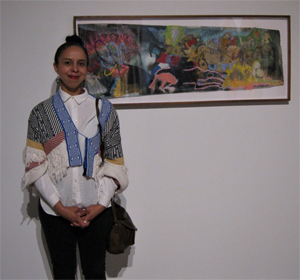
Another talented artist, Griselda Rojas, teamed up with an Indian researcher, Dr. Ramachandran from UC San Diego. They must have had some fascinating interchanges based on what Rojas had to say on how she went about conceiving her work.
She said, “I focused my research on his published paper entitled, ‘The Science of Art: A Neurological Theory of Aesthetic Experience.’ This research addresses multiple universal principles regarding psychological phenomena including Peak Shift Affect, which grabbed my attention. The Peak Shift Affect explains a well-known principle in animal discrimination learning and explains individual responses to face and body attractiveness. Drs. Ramachandran and Hirstein compare the peak shift effect to the Sanskrit word ‘rasa,’ which in Hindi means the ‘taste’ or essence of an impression; the aesthetic experience in transcendence; the emotional fulfillment of the soul; the nectar of life. ‘Raza’ in Spanish means ‘The People.’ Spelled with the letter ‘z,’ it is pronounced the same way as the Hindi term ‘Rasa.'”
She continued, “My work addresses the chaotic breakdown of class and race structures after colonialism and territorialism overtook both India and the New World. Aesthetic influences migrated both ways.” Heady stuff! Her lovely piece, using a tablecloth with Indian images as a collage, reflects that.
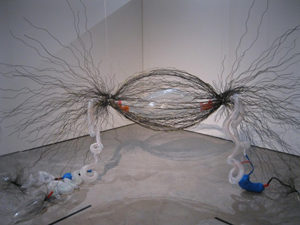
There were many pieces to admire, but I have to say that my favorite was one by Hugo Heredia. His piece reminded me of the well-known glass artist, Dale Chihuly.
Heredia collaborated with Dr. Vipul Shukla of the Rao Lab at the La Jolla Institute of Immunology. Dr. Shukla’s research is on DNA and cancer cells and understanding the mechanisms by which cancers originate. Heredia’s beautiful piece is constructed of fused and inflated glass, fabricated steel, steel cable and plastic fiber tubing. Heredia said that he wants people to see how strong and delicate and sensitive cells are and how, like glass, they can break at any moment.
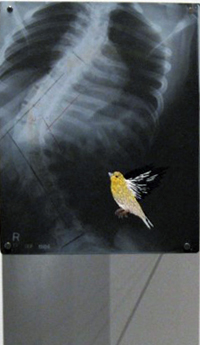
Another piece that caught my eye was by Bavhna Mehta, an Indian artist who had polio as a child and is in a wheelchair. Her lovely piece had a radiology picture of her curved spine next to it.
There were too many fascinating pieces to write about here, including some great interactive pieces, so plan to spend some time there when you visit.
I was lucky enough to go a media preview where I had a very knowledgeable docent, Sue Knop, walking around with me. It helps to understand the pieces better when you have someone explaining the science behind them.
Kudos to San Diego Art Institute’s executive director, Jacqueline Silverman, for thinking outside of the box.
“Illumination: 21st Century Interactions with Art + Science + Technology”
When: Feb. 8-May 3
Where: San Diego Art Institute, 1439 El Prado, Balboa Park
Tickets: Free
Phone: (619) 236-0011
Online: sandiego-art.org
*
Mimi Pollack is a freelance writer based in La Mesa, California. She may be contacted via mimi.pollack@sdjewishworld.com
I am excited to see this exhibition from the review, as it sounds like a truly remarkable idea for a collaborative exhibition in a long time. To be able to visualize science is an amazing feat, since technology and science are so complex. Thank you Mimi for bringing this to my attention.
Vivian Blackstone